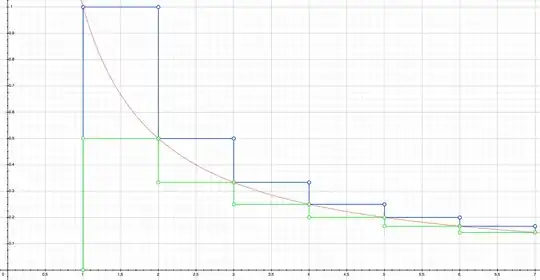Possible Duplicate:
Why does 1/x diverge?
I'm a math tutor. This is a high school level problem. I'm unable to solve this.
What is the value of:
$\lim\limits_{n \to \infty}\sum\limits_{k=1}^n \frac{1}{k}$
Possible Duplicate:
Why does 1/x diverge?
I'm a math tutor. This is a high school level problem. I'm unable to solve this.
What is the value of:
$\lim\limits_{n \to \infty}\sum\limits_{k=1}^n \frac{1}{k}$

From the figure, you can see that the area under the blue-curve is bounded below by the area under the red-curve from $1$ to $\infty$.
The blue-curve takes the value $\frac1{k}$ over an interval $[k,k+1)$
The red-curve is given by $f(x) = \frac1{x}$ where $x \in [1,\infty)$
The green-curve takes the value $\frac1{k+1}$ over an interval $[k,k+1)$
The area under the blue-curve represents the sum $\displaystyle \sum_{k=1}^{n} \frac1{k}$ while the area under the red-curve is given by the integral $\displaystyle \int_{1}^{n+1} \frac{dx}{x}$ while the area under the blue-curve represents the sum $\displaystyle \sum_{k=1}^{n} \frac1{k+1}$
Hence, we get $\displaystyle \sum_{k=1}^{n} \frac1{k} > \displaystyle \int_{1}^{n+1} \frac{dx}{x} = \log(n+1)$
$\log(n+1)$ diverges as $n \rightarrow \infty$ and hence $$\lim_{n \rightarrow \infty} \displaystyle \sum_{k=1}^{n} \frac1{k} = + \infty$$
By a similar argument, by comparing the areas under the red curve and the green curve, we get $$\displaystyle \sum_{k=1}^{n} \frac1{k+1} < \displaystyle \int_{1}^{n+1} \frac{dx}{x} = \log(n+1)$$ and hence we can bound $\displaystyle \sum_{k=1}^{n} \frac1{k}$ from above by $1 + \log(n+1)$
Hence, $\forall n$, we have $$\log(n+1) < \displaystyle \sum_{k=1}^{n} \frac1{k} < 1 + \log(n+1)$$
Hence, we get $0 < \displaystyle \sum_{k=1}^{n} \frac1{k} - \log(n+1) < 1$, $\forall n$
Hence, if $a_n = \displaystyle \sum_{k=1}^{n} \frac1{k} - \log(n+1)$ we have that $a_n$ is a monotonically increasing sequence and is bounded.
Hence, $\displaystyle \lim_{n \rightarrow \infty} a_n$ exists. This limit is denoted by $\gamma$ and is called the Euler-Mascheroni constant.
It is not had to show that $\gamma \in (0.5,0.6)$ by looking at the difference in the area of these graphs and summing up the area of these approximate triangles.
You'd think it would converge but it doesn't.
An easy way to see this is to consider the subsequences from $\frac1{2^k}$ to $\frac1{2^{k+1}}$. Since $\frac1{2^{k+1}}$ is less than $\frac1{2^k}$, consider replacing all values between them with the last one. That is:
$$1 + 1/2+1/4 + 1/4+1/8 + 1/8 + 1/8+1/8+1/8+ 1/16 + 1/16+...$$
Since each subsequence sums to $1/2$, each time you go from $n = 2^m$ to $n=2^{m+1}$, you're adding 1/2, so in the limit it won't ever converge.